
Groundwater is a favorite topic of ours here at Advanced Geosciences. There is just so much to discuss! Not only is groundwater exploration an everyday use of electrical resistivity imaging (ERI), but understanding groundwater can reshape our relationship with an invaluable resource. This time, we want to look at groundwater discharge and the delicate balance it serves on a global scale.
In short...
Underground aquifers are layers of sediments or fractured rock and soil that contain water. These are the go-to sources for an abundance of groundwater. When the water in an aquifer reaches a certain saturation level, it can flow out of the ground and into surface water bodies—which we call groundwater discharge.
This process can occur naturally through gravity or human activities— such as the construction of wells or pumping stations. Groundwater discharge is an essential source of water for many communities around the world. In areas with limited surface water resources, groundwater can be a vital source of drinking water and irrigation.
Let's dig deeper...
There are two primary types of groundwater discharge: diffuse and focused.
Diffuse discharge occurs when groundwater seeps slowly and uniformly into surface water bodies or evaporates directly into the atmosphere through evapotranspiration. Surface water bodies can mean streams, springs, rivers, and lakes. Conversely, focused release occurs through discrete points or features like springs, seeps, and wells.
Here are some examples:
Diffuse Discharge:
- Seepage faces: Groundwater gradually seeps out from the banks of a river, lake, or stream, creating a wet, marshy area.
- Evapotranspiration: Water from the shallow groundwater table is absorbed by plant roots and released into the atmosphere through transpiration or evaporates directly from the soil surface.
- Baseflow: Groundwater slowly and uniformly discharges into a river, maintaining the river's flow during dry periods.
- Wetlands: In areas where the water table is near the surface, groundwater discharges diffusely, creating swampy or marshy ecosystems that support unique plant and animal life.
Focused Discharge:
- Springs: Groundwater emerges from the ground at a distinct point due to changes in geology or the intersection of the water table with the Earth's surface, forming a natural spring.
- Seeps: Small, localized areas where groundwater discharges through permeable sediments or fractures in rock, often creating damp patches on the ground or along the side of a hill.
- Wells: Human-made structures that tap into an aquifer and provide a focused point of discharge for groundwater, either through pumping or artesian pressure.
- Gaining streams: Streams that receive a significant groundwater inflow through one or more focused discharge points, increasing their flow rate and volume.

Diffuse and focused discharge play crucial roles in the hydrological cycle. It can also help to maintain the health and biodiversity of surface water ecosystems, as the influx of fresh groundwater can help to oxygenate and nourish these systems. Groundwater discharge plays a critical role in the global water cycle, as it helps replenish surface water sources and maintain the water balance on the planet.
Key factors influencing groundwater discharge include:
- Hydraulic head: The driving force behind groundwater flow, it represents the potential energy in the system. Higher hydraulic head gradients lead to increased flow and, subsequently, higher discharge rates.
- Aquifer properties: The permeability and porosity of the geological formations that make up the aquifer dictate the ease with which water can flow through the subsurface. Higher permeability and porosity facilitate increased discharge.
- Recharge: Replenishing groundwater through precipitation, snowmelt, or surface water infiltration is essential for maintaining groundwater levels and discharge rates. Recharge rates are influenced by factors such as climate, land use, and soil characteristics.
- Groundwater-surface water interactions: The connection between groundwater and surface water systems is critical to groundwater discharge. The degree of interaction between these systems affects the rate and location of discharge.
As a geophysicist, we naturally use geophysical methods for groundwater exploration and studies. These non-invasive techniques provide subsurface information that can be used to infer aquifer properties and groundwater flow patterns. Electrical resistivity imaging, ground-penetrating radar, and seismic surveys help delineate aquifer boundaries and identify preferential flow pathways.
However, there are other techniques for exploration, such as hydrological measurements, hydrochemical and isotopic tracers, numerical modeling, and studying satellite data.
Negative Impacts:
Excessive or uncontrolled groundwater discharge can also have negative impacts. Over-pumping of groundwater can lead to the depletion of aquifers, which can cause the land above the aquifer to sink and result in long-term water shortages. Groundwater discharge can also contribute to water pollution if the water contains contaminants, such as pesticides or chemicals from industrial activities.

So, what can we do to ensure we're using groundwater responsibly? Here are a few ideas:
- Conserve water: Little things like turning off the tap while brushing your teeth, fixing leaks, and using water-saving appliances can add significant savings in the long run.
- Upgrade irrigation methods: Farmers can switch to more efficient watering techniques, like drip irrigation, which delivers water directly to the plant roots and minimizes evaporation and runoff.
- Keep an eye on groundwater levels: By monitoring how much water we're taking out of aquifers and comparing it to the natural recharge rate, we can ensure we're doing it correctly.
- Put rules in place: Governments and local authorities can set up permits and regulations to control how much groundwater can be extracted, ensuring everyone gets a fair share without draining the aquifers.
Understanding and managing groundwater discharge is vital for sustainable water resource management, as it influences water availability, ecosystem health, and water quality.


